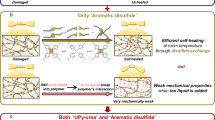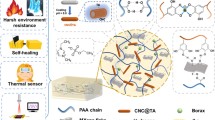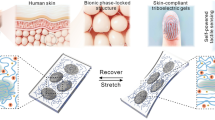Abstract
Inspired by the multi-layer architecture of mammal skins, interfacial robust, stretchable, and entirely healable gel-elastomer hybrids hold great potential in diverse fields including biomedical devices, wearable electrical devices, and soft robotics. However, existing gel-elastomer hybrids have numerous limitations including low interfacial bonding toughness, complex and time-consuming preparation process, unhealable, and non-reconfiguration. Herein, we propose a simple and general chemical strategy through the interfacial dynamic bonding between gel and elastomer to simultaneously address the abovementioned obstacles. Dynamic covalent bonds readily and repeatably covalent bonding ionogel and elastomer (interfacial toughness: 390 J m−2), endowed the hybrids with entire self-healing features like skin and enabled discretionary assembly and reconfiguration. Moreover, this strategy resolved the troublesome contradiction between interfacial stability and reconfiguration. Taking advantage of the aforementioned features, we readily constructed a multi-module, self-healing, self-powered, and realtime monitoring of personal status integrated elastic electronics, which could simply reconfigure the output signal of elastic electronics into an input signal of the devices-braille keyboard.

Similar content being viewed by others
References
Li H, Xu F, Guan T, Li Y, Sun J. Nano Energy, 2021, 90: 106645
Li J, Sun J, Wu D, Huang W, Zhu M, Reichmanis E, Yang S. Adv Fiber Mater, 2019, 1: 71–81
Dobashi Y, Yao D, Petel Y, Nguyen TN, Sarwar MS, Thabet Y, Ng CLW, Scabeni Glitz E, Nguyen GTM, Plesse C, Vidal F, Michal CA, Madden JDW. Science, 2022, 376: 502–507
Yuan J, Mecerreyes D, Antonietti M. Prog Polym Sci, 2013, 38: 1009–1036
Someya T, Bao Z, Malliaras GG. Nature, 2016, 540: 379–385
Yang L, Liu Z, Neisiany RE, Lou J, Guo Y, Zhang L, Liu H, Chen S, Gu S, You Z. Sci China Chem, 2023, 66: 3213–3222
Kim Y, Suh JM, Shin J, Liu Y, Yeon H, Qiao K, Kum HS, Kim C, Lee HE, Choi C, Kim H, Lee D, Lee J, Kang JH, Park BI, Kang S, Kim J, Kim S, Perozek JA, Wang K, Park Y, Kishen K, Kong L, Palacios T, Park J, Park MC, Kim H, Lee YS, Lee K, Bae SH, Kong W, Han J, Kim J. Science, 2022, 377: 859–864
Sun L, Huang H, Guan Q, Yang L, Zhang L, Hu B, Neisiany RE, You Z, Zhu M. CCS Chem, 2023, 5: 1096–1107
Zhang L, Xiong H, Wu Q, Peng Y, Zhu Y, Wang H, Yang Y, Liu X, Huang G, Wu J. Sci China Mater, 2021, 64: 1780–1790
Hu D, Giorgio-Serchi F, Zhang S, Yang Y. Nat Mach Intell, 2023, 5: 261–272
Li CH, Wang C, Keplinger C, Zuo JL, Jin L, Sun Y, Zheng P, Cao Y, Lissel F, Linder C, You XZ, Bao Z. Nat Chem, 2016, 8: 618–624
Markvicka EJ, Bartlett MD, Huang X, Majidi C. Nat Mater, 2018, 17: 618–624
Sun L, Huang H, Ding Q, Guo Y, Sun W, Wu Z, Qin M, Guan Q, You Z. Adv Fiber Mater, 2022, 4: 98–107
Yang L, Sun L, Huang H, Zhu W, Wang Y, Wu Z, Neisiany RE, Gu S, You Z. Adv Sci, 2023, 10: 2207527
Wu KS, Stefik MM, Ananthapadmanabhan KP, Dauskardt RH. Biomaterials, 2006, 27: 5861–5870
Zhang L, Liang J, Jiang C, Liu Z, Sun L, Chen S, Xuan H, Lei D, Guan Q, Ye X, You Z. Natl Sci Rev, 2021, 8: nwaa154
Liu K, Jiang Y, Bao Z, Yan X. CCS Chem, 2019, 1: 431–447
Ruth SRA, Beker L, Tran H, Feig VR, Matsuhisa N, Bao Z. Adv Funct Mater, 2020, 30: 1903100
Shi J, Dai Y, Cheng Y, Xie S, Li G, Liu Y, Wang J, Zhang R, Bai N, Cai M, Zhang Y, Zhan Y, Zhang Z, Yu C, Guo CF. Sci Adv, 2023, 9: eadf8831
Kim CC, Lee HH, Oh KH, Sun JY. Science, 2016, 353: 682–687
Matsuhisa N, Niu S, O’Neill SJK, Kang J, Ochiai Y, Katsumata T, Wu HC, Ashizawa M, Wang GJN, Zhong D, Wang X, Gong X, Ning R, Gong H, You I, Zheng Y, Zhang Z, Tok JBH, Chen X, Bao Z. Nature, 2021, 600: 246–252
Choi DK, Kim DH, Lee CM, Hafeez H, Sarker S, Yang JS, Chae HJ, Jeong GW, Choi DH, Kim TW, Yoo S, Song J, Ma BS, Kim TS, Kim CH, Lee HJ, Lee JW, Kim D, Bae TS, Yu SM, Kang YC, Park J, Kim KH, Sujak M, Song M, Kim CS, Ryu SY. Nat Commun, 2021, 12: 2864
Parida K, Thangavel G, Cai G, Zhou X, Park S, Xiong J, Lee PS. Nat Commun, 2019, 10: 2158
Chen S, Huang T, Zuo H, Qian S, Guo Y, Sun L, Lei D, Wu Q, Zhu B, He C, Mo X, Jeffries E, Yu H, You Z. Adv Funct Mater, 2018, 28: 1805108
Zhang Q, Li Y, Cai H, Yao M, Zhang H, Guo L, Lv Z, Li M, Lu X, Ren C, Zhang P, Zhang Y, Shi X, Ding G, Yao J, Yang Z, Wang ZL. Adv Mater, 2021, 33: 2105761
Tang J, Li J, Vlassak JJ, Suo Z. Soft Matter, 2016, 12: 1093–1099
Yin X, Zhang Y, Xiao J, Moorlag C, Yang J. Adv Funct Mater, 2019, 29: 1904716
Yang C, Suo Z. Nat Rev Mater, 2018, 3: 125–142
Yang C, Cheng S, Yao X, Nian G, Liu Q, Suo Z. Adv Mater, 2020, 32: 2005545
Ge Q, Chen Z, Cheng J, Zhang B, Zhang YF, Li H, He X, Yuan C, Liu J, Magdassi S, Qu S. Sci Adv, 2021, 7: eaba4261
Wirthl D, Pichler R, Drack M, Kettlguber G, Moser R, Gerstmayr R, Hartmann F, Bradt E, Kaltseis R, Siket CM, Schausberger SE, Hild S, Bauer S, Kaltenbrunner M. Sci Adv, 2017, 3: e1700053
Li J, Celiz AD, Yang J, Yang Q, Wamala I, Whyte W, Seo BR, Vasilyev NV, Vlassak JJ, Suo Z, Mooney DJ. Science, 2017, 357: 378–381
Mark JE, Erman B, Roland M. The Science and Technology of Rubber. New York: Academic Press, 2013
Hubbard AM, Cui W, Huang Y, Takahashi R, Dickey MD, Genzer J, King DR, Gong JP. Matter, 2019, 1: 674–689
Yuk H, Zhang T, Parada GA, Liu X, Zhao X. Nat Commun, 2016, 7: 12028
Liu Q, Nian G, Yang C, Qu S, Suo Z. Nat Commun, 2018, 9: 846
Qian W, Texter J, Yan F. Chem Soc Rev, 2017, 46: 1124–1159
Cao Y, Tan YJ, Li S, Lee WW, Guo H, Cai Y, Wang C, Tee BCK. Nat Electron, 2019, 2: 75–82
Tamate R, Hashimoto K, Horii T, Hirasawa M, Li X, Shibayama M, Watanabe M. Adv Mater, 2018, 30: 1802792
Lai Y, Wu H, Lin H, Chang C, Chou H, Hsiao Y, Wu Y. Adv Funct Mater, 2019, 29: 1904626
Kang J, Tok JBH, Bao Z. Nat Electron, 2019, 2: 144–150
Wu J, Liu H, Chen W, Ma B, Ju H. Nat Rev Bioeng, 2023, 1: 346–360
Acknowledgements
This work was supported by the National Key Research and Development Program of China (2021YFC2101800, 2021YFC2400802), the National Natural Science Foundation of China (52173117, 21991123), the Ningbo 2025 Science and Technology Major Project (2019B10068) and the Science and Technology Commission of Shanghai (20DZ2254900, 20DZ2270800).
Author information
Authors and Affiliations
Corresponding author
Ethics declarations
Conflict of interest The authors declare no conflict of interest.
Additional information
Supporting information The supporting information is available online at chem.scichina.com and link.springer.com/journal/11426. The supporting materials are published as submitted, without typesetting or editing. The responsibility for scientific accuracy and content remains entirely with the authors.
Electronic supplementary material
11426_2023_1904_MOESM1_ESM.docx
An interfacial robust and entire self-healing ionogel-elastomer hybrid for elastic electronics enables discretionary assembly and reconfiguration
Rights and permissions
About this article
Cite this article
Yang, L., Sun, L., Huang, H. et al. An interfacial robust and entire self-healing ionogel-elastomer hybrid for elastic electronics enables discretionary assembly and reconfiguration. Sci. China Chem. 67, 1316–1323 (2024). https://doi.org/10.1007/s11426-023-1904-0
Received:
Accepted:
Published:
Issue Date:
DOI: https://doi.org/10.1007/s11426-023-1904-0




